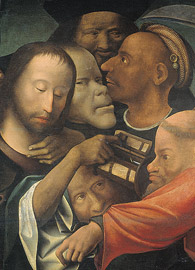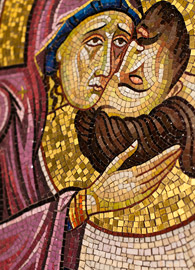John Week 9
Betrayal, Denial, and Death: The End? (John 18:1–19:42)
Seattle Pacific University Assistant Professor of New Testament
Read this week’s Scripture: John 18:1–19:42
16:44
Key Prologue Terms: Father/Son, revelation, grace and truth, flesh
From Arrest to Burial, in Six Steps

 Enlarge
Enlarge
John 18 begins the very familiar story of Judas’ betrayal of Jesus, and of Jesus’ arrest, trial, crucifixion, and burial. In many ways these chapters of the Gospel of John most closely resemble the parallel chapters in Matthew, Mark, and Luke. All four gospels share the same overall steps from betrayal to burial.
Beyond these similarities, however, a reader of all four gospels can find some interesting differences in John’s gospel. These differences are valuable because they help illuminate the particular characteristics of Jesus that the Gospel of John desires to highlight. The fourth gospel portrays a Jesus who is always cognizant of events that are about to happen and is always in control of his situation.
We will hear more comments about Jesus’ kingship and others’ reactions to his kingship in these chapters. John’s gospel is clear: Jesus’ kingship is grounded in his death on the cross. Beyond control and kingship, however, the narration of Jesus’ death makes it transparent that Jesus dies as a new Passover Lamb for God’s people. Finally, Jesus’ death marks the continuation of God’s plan as Jesus fulfills Scripture and establishes a new community, even as he is dying.
These four components are woven through different sections of John 18–19:
- Jesus’ foreknowledge and control
- Jesus’ kingship
- Jesus’ death as a new Passover Lamb
- Jesus’ formation of a new community
Step One: Betrayal and Arrest (John 18:1–11)
Jesus has just finished speaking for nearly three and a half chapters straight (John 13–17). He instructed the disciples about his coming betrayal and death after washing their feet. He taught them about love and the coming of another Advocate, the Holy Spirit, who would remind them of everything. Jesus then prayed for them and those who would come after them. Now, “after Jesus had spoken these words,” (18:1) the story of his arrest begins. This is in contrast to the narrative in the synoptics, as there Jesus is arrested “while he was still speaking” to his disciples (Matthew 26:47; Mark 14:43; Luke 22:47). John’s point is that Jesus is not surprised by his arrest; indeed, it happens only when he is finished instructing his disciples.
Judas does not kiss Jesus to betray him (e.g., Matthew 26:48; Mark 14:45; Luke 22:48). Instead Jesus takes control and asks Judas and the multitude with him whom they seek (18:3–4). John clarifies yet again that Jesus knows what is going to happen (18:4). He will not be betrayed on someone else’s timeline (i.e., Judas’) or without his consent.
When those who come to arrest Jesus declare that they seek Jesus of Nazareth, Jesus replies, “I am he,” and his listeners fall to the ground (18:6). This is because Jesus’ reply is again evoking the divine name Yahweh (“I am who I am” is one possible translation of the Hebrew word that is God’s name; see Exodus 3:14; Isaiah 45:5–7; 48:12). Those who seek to arrest Jesus are standing on holy ground just like Moses is when he learns God’s name in Exodus (Exodus 3:5–6). However, this group does not recognize Jesus’ identity. Their physical reaction but continued ignorance shows the depth of their spiritual blindness (cf. John 9:40–41).
Finally, Jesus’ control in his betrayal and arrest is demonstrated through the way John narrates the disciples’ departure from Jesus’ presence. In Matthew and Mark the disciples flee, avoiding arrest (Matthew 26:56; Mark 14:50). In John, however, Jesus declares to the authorities that they should let his followers go (18:8). [Author’s Note 1]
Step Two: Questions (18:12–27)
In the second section John alternates between the story of Jesus being questioned by the high priest, Annas, and the story of others questioning his disciple Peter. The fourth gospel narrates these stories slightly differently than the synoptics. The main differences are who is present with Peter and who questions Jesus. [Author’s Note 2]
Peter denies being one of Jesus’ disciples (18:17, 25) and being with Jesus in the garden at the time of Jesus’ arrest (18:26–27). In the first two denials, Peter says, “I am not,” in reply to the questioners. This response takes on further significance in John in light of Jesus’ confession, “I am” Jesus of Nazareth, whom you seek (18:5). Jesus confesses that he is not only Jesus of Nazareth but also God, yet Peter negates that expression entirely. The structure of this passage creates an alternating chorus of “I am” and “I am not.”
Annas questions Jesus about his disciples and his teaching (18:19). Given that one of his disciples is actively denying him at the same time that Annas asks the question, we should see some irony in this order of events. In Mark, Jesus does not declare that he is the Messiah until the trial by the Jewish authorities. In John, Jesus has been making this declaration, among others, all along. We need no trial from the Jerusalem authorities; they have already convicted Jesus on the basis of the evidence he has given (e.g., 10:24–25, 33). So there is no council meeting, there are no formal charges or trial, and there is no verdict given.
Step Three: Jesus and Pilate (18:28–19:16a)
This section is the major component of John’s passion narrative. John structures the encounter differently than the synoptics do. There are seven scenes, which alternate between Pilate’s conversations with Jewish officials (scenes 1, 3, 5, and 7) and Pilate’s conversations with Jesus (scenes 2, 4, and 6). In this way the gospel makes Pilate a pivotal but ambiguous character and portrays the Jewish authorities as condemning themselves.
In the first scene (18:28–32), Pilate and the Jewish authorities talk outside the praetorium, Pilate’s headquarters. [Author’s Note 3] John reminds his readers that Passover has not happened yet by stating that the Jewish authorities remained outside Pilate’s headquarters to prevent from becoming ritually unclean. [Author’s Note 4] This raises the irony for John’s audience: which event should render them more unclean, arresting an innocent man or walking into a Gentile’s house? Irony is particularly evident throughout many of these scenes, as there is much information that Pilate does not know, but the reader does. Moreover, John’s audience is assured by the repeated statement that Jesus knew all of these events beforehand (18:32). [Author’s Note 5]
In the second scene (18:33–38a), Pilate questions Jesus for the first time. This conversation delineates the two primary theological themes of the trial narrative. Pilate asks Jesus if he is “the King of the Jews” (18:33). Jesus’ response concerning where Pilate obtained this information (18:34) seems appropriate. None of the previous conversation seems to connect Jesus with claims of kingship. Such claims would render Jesus guilty of treason against Caesar, who was the only king in the Roman Empire. In fact, while Jesus talks a lot about the kingdom of God in the synoptic gospels, it is rarely mentioned in John. Nevertheless, it is clear that Jesus was crucified on charges of treason for claiming to be the king of the Jews (cf. 19:19–22). [Author’s Note 6]
Jesus’ reply to Pilate is remarkably cryptic. He says, “My kingdom is not from this world”
(18:36). Remember, “the world” is defined as those who have opposed Jesus. Therefore, those of “the world” are not the subjects of his kingdom. Jesus is also alluding to his origin, as he has throughout the gospel: he is not of this world, just as his kingdom is not of this world. They are both from God. This does not mean that Jesus seeks to establish a kingdom elsewhere. It means that everyone who belongs to this kingdom “listens to [Jesus’] voice” (18:37; cf. 10:3–5). Pilate follows up his queries with the question “What is truth?” (18:38a), a question favored by the curious, doubters, and skeptics alike. The gospel’s answer to this question is as straightforward as it may be philosophically challenging: truth is Jesus. The gospel does not explain further.
The third scene (18:38b–40) shows Pilate conversing with the authorities again, offering to free Barabbas instead of Jesus. Barabbas is a “bandit,” an insurrectionist against Rome (18:40). Jesus earlier alluded to these bandits or insurrectionists, often messianic claimants, when he asserted that all those who came before him were “thieves and bandits; but the sheep did not listen to them” (John 10:8).
The fourth scene (19:1–3) shows Pilate back with Jesus and the soldiers. Though Pilate proclaims Jesus’ innocence (18:38), he does not hesitate to have Jesus flogged. These floggings could be fatal, as the whips used had metal pieces in them and could draw substantial amounts of blood. In this way, Pilate’s proclamations of innocence do not fully match his actions. Regardless, the soldiers dress Jesus in a kingly purple robe and a crown of thorns (19:2).
In the fifth scene (19:4–7), Jesus is still wearing these clothes that mock him as a king when Pilate presents him to the Jewish authorities. It is important to note that there is no crowd of people present at this point, unlike in the synoptic gospels. Only the chief priests and the police shout, “Crucify him!” (19:6), after Pilate has said, “Here is the man” (19:5).
In the sixth scene (19:8–11), Pilate explicitly raises the question of origin, asking Jesus where he is from. On the surface this is a very appropriate question to ask. Many messianic claimants came from Galilee, so knowing Jesus’ family origin could theoretically help Pilate determine the case against Jesus. However, the gospel’s reader knows that this is again a question about Jesus’ connections to God: he is both from Galilee and from heaven.
The final scene describes Pilate handing Jesus over to the Jewish authorities (19:12–16a). They demand Jesus’ conviction. They claim that Pilate will be “no friend of the emperor” if he releases Jesus (19:12). The Jewish authorities disdain any claim that they desire a messiah — even a political messiah — to free them from Roman rule. In condemning Jesus, according to the fourth gospel, they condemn themselves to be ruled by the Roman Empire. [Author’s Note 7] Jesus will be crucified at the same time that the Passover lambs are sacrificed: noon (19:14).
Step Four: On the Cross (19:16b–30)

 Enlarge
Enlarge
Jesus’ identity as the Passover lamb is yet another way to claim what John’s gospel has said all along. Jesus has come to provide salvation from sin and oppression, and to triumph over death, offering abundant life instead. The Passover lamb provided freedom from the sin and oppression of a tyrannical ruler, and from the Angel of Death. In this way, Jesus’ death offers deliverance once again, as God acts now in the same way that God acted in Exodus, for the salvation of the world (John 4:42). [Author’s Note 8]
Before he dies, Jesus performs one more action on behalf of his followers. In John, there are women near the cross, including Jesus’ mother (19:25). Jesus unites his mother and the disciple he loved into a new community, like a new family (19:26–27). While this has often been interpreted in various symbolic ways (e.g., Mary and the Church), within the gospel, it likely points to Jesus’ control and concern for others despite his pain and death. Moreover, it reflects his words to his disciples about the necessity of his departure so that another Advocate can come and continue to facilitate the community of love and truth (14:26–27). Jesus is already looking beyond the narrative horizon of the gospel and into the Church’s future.
Jesus’ final words from the cross are “It is finished” (19:30), meaning that everything he had come to do is now completed (cf. 4:34; 5:36; 17:4). He then gives up his spirit of his own accord. Unlike in Matthew, Mark, and Luke, no centurion or any other bystander confirms Jesus’ identity as the Son of God, or Jesus’ innocence. In John, the reader knows Jesus’ identity already, and his death simply completes that revelation.
Step Five: Jesus’ Side is Pierced (19:31–37)
While we have known for quite some time that Jesus’ death occurs on Passover, the first note that the Passover was held on a Friday comes in 19:31. The Jewish authorities want to take the bodies down off the crosses so that they are not left unburied overnight, and over the Sabbath. Such exposure would violate Deuteronomy 21:22–23. While there is no need to break Jesus’ legs, the soldiers do pierce his side (19:34). [Author’s Note 9] The outflow of blood and water may simply be to prove that Jesus is really, humanly, dead. The sorrow of his followers — or even those who were curious (see step six) — is real. Resurrection is real to them, too. But at this point in the gospel, it still means something that happens at the end of time, not something that may happen on the coming Sunday (see 11:21–27).
Step Six: Jesus’ Burial (19:38–42)
In this passage Nicodemus reappears with a new character, Joseph of Arimathea. Only in John is Nicodemus involved in Jesus’ burial. These two characters seem to be united over their “fear of the Jews” (19:38) — fear of authorities, fear of death, and fear of loss — but these fears do not keep them from providing Jesus with an extravagant burial. Nicodemus provides approximately 75 pounds (34 kilograms) of spices (19:39). It is up to the reader to decide if this is an extravagant offering of honor, akin to Mary’s anointing (12:1–8), or a lack of faith in Jesus’ resurrection.
Finally, we finish where we began: in a garden (18:1; 19:41; cf. Genesis 2:8). What a difference this garden will make on Sunday morning.
Questions for Further Reflection
- How would you summarize John’s portrayal of Jesus in these chapters? What do you think it is most important to notice among John’s themes?
- The character of Pilate, particularly as portrayed in the Gospel of John, has sparked many imaginations in art and literature. Do you find Pilate to be a compelling or compassionate figure? Why or why not?
<<Previous Lectio Back to John Next Lectio>>

This work is licensed under a Creative Commons License.




